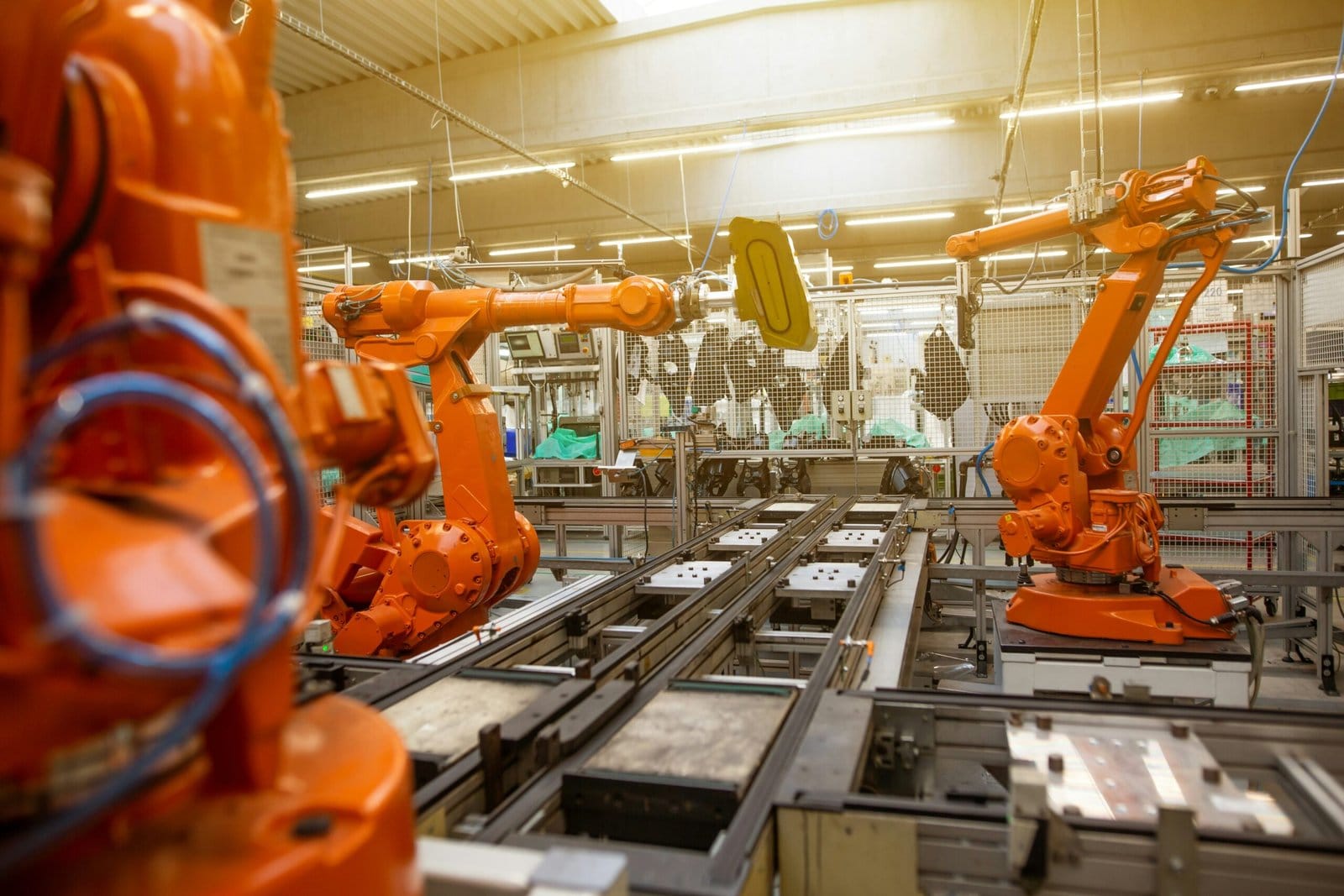Your cart is currently empty!

Introduction to Industry 4.0
Industry 4.0 represents a significant evolution in the manufacturing sector, marking the transition from traditional production methods to a digitally enhanced environment. This concept, often referred to as the Fourth Industrial Revolution, emphasizes the groundbreaking integration of advanced digital technologies in manufacturing processes. The essence of Industry 4.0 lies in its capability to create smart factories, where machines, systems, and networks communicate and collaborate to facilitate more efficient and flexible production.
The importance of Industry 4.0 cannot be overstated; it fundamentally alters operations, offering numerous benefits such as increased productivity, improved efficiency, and enhanced product quality. At its core, Industry 4.0 utilizes key technologies such as the Internet of Things (IoT), artificial intelligence (AI), big data analytics, and automation to foster a connected and intelligent manufacturing environment. These innovations enable real-time data collection and analysis, leading to smarter decision-making and operational optimization.
Furthermore, Industry 4.0 encourages a shift towards customized production, allowing manufacturers to respond swiftly to changing market demands and consumer preferences. This flexibility is vital in today’s fast-paced economy, where personalization and rapid response to trends play a crucial role in maintaining competitiveness. By integrating these digital technologies, manufacturers can not only enhance their operational capabilities but also create new business models and revenue streams.
As we delve deeper into the various facets of smart manufacturing, understanding the foundational principles of Industry 4.0 is essential. This will provide insights into how these advancements not only transform production processes but also shape future trends. The ongoing evolution of Industry 4.0 continues to redefine what is possible within the manufacturing sector, making it an exciting topic for exploration and discussion.
The Role of the Internet of Things (IoT) in Manufacturing
The Internet of Things (IoT) represents a transformative force in the manufacturing sector, enabling a level of connectivity and data exchange that was previously unattainable. In a typical manufacturing environment, a variety of IoT devices, including sensors, actuators, and smart machinery, play a crucial role. These devices continuously gather and transmit data, facilitating real-time monitoring and allowing manufacturers to gain deeper insights into their operations.
IoT devices are connected through a robust network infrastructure, often utilizing cloud-based platforms for data storage and analysis. This connectivity allows for seamless communication between machines and personnel, enabling manufacturers to track processes, manage resources, and pinpoint inefficiencies quickly. For example, smart sensors can monitor temperature, humidity, or machine performance, sending alerts when anomalies occur. This immediate feedback loop contributes greatly to preventive maintenance strategies, reducing downtime and prolonging the lifespan of equipment.
The benefits of implementing IoT in manufacturing are manifold. Enhanced data collection capabilities allow for detailed analytics, leading to improved operational efficiency and decision-making. Manufacturers can optimize production schedules by analyzing real-time data on machine usage and inventory levels, resulting in reduced waste and cost savings. Furthermore, IoT technologies foster greater flexibility; factories can quickly adapt to changing market demands through automated adjustments in production processes.
Moreover, the integration of IoT in manufacturing can lead to improved safety standards. Connected devices can monitor hazardous conditions in real-time, alerting workers and ensuring compliance with safety regulations. Overall, the Internet of Things is not just a technological advancement; it is a fundamental shift that empowers manufacturers to enhance their operational capabilities and stay competitive in a rapidly evolving industry.
Automation and Robotics in Production Lines
The manufacturing industry has witnessed a remarkable transformation with the advent of automation and robotics. These technologies are integral to Industry 4.0, significantly enhancing productivity and precision in production lines. By streamlining various processes, from assembly to quality control, automation allows manufacturers to produce goods more efficiently, while minimizing human error. The implementation of robotic systems can lead to substantial reductions in operational costs, which is a vital consideration for businesses striving to remain competitive in a global market.
Among the various types of robots utilized in manufacturing, industrial robots stand out due to their versatility and strength. These machines are commonly employed for tasks such as welding, painting, and packaging, where they can perform repetitive tasks with high accuracy. On the other hand, collaborative robots, often referred to as cobots, are designed to work alongside human operators. Cobots enhance workforce efficiency by assisting with tasks that require dexterity and adaptability. This collaboration allows manufacturers to leverage the strengths of both humans and machines, creating an environment where productivity is maximized.
The implications of integrating automation and robotics into manufacturing workflows extend beyond immediate productivity gains. The workforce is also significantly impacted as tasks traditionally performed by humans become automated. This shift necessitates workforce upskilling and reskilling to accommodate new technologies. As a result, employees must adapt to new roles that complement robotic systems, focusing on supervision, maintenance, and advanced problem-solving skills. Consequently, manufacturers can cultivate a more skilled workforce that is better equipped to drive innovation and respond to evolving market demands.
In summary, the rise of automation and robotics in production lines marks a pivotal shift in the manufacturing landscape. These technologies not only enhance efficiency and precision but also reshape the workforce dynamics, presenting both challenges and opportunities for companies and employees alike.
Real-Time Data Analytics: The Key to Improvement
In the context of Industry 4.0, real-time data analytics serves as a cornerstone for enhancing decision-making processes in manufacturing. Utilizing advanced technologies, manufacturers are now capable of collecting vast amounts of data from various sources, including machinery, equipment, and supply chains. This data collection is facilitated through sensors, IoT devices, and automated systems, which gather information continuously during the production cycles.
Once the data has been collected, various tools and techniques come into play for analysis. Predictive analytics, for example, enables manufacturers to forecast potential disruptions before they occur, and prescriptive analytics offers actionable insights for optimizing processes. Data visualization tools also assist in presenting complex data sets in a comprehensible format, allowing decision-makers to grasp insights quickly and act decisively. By leveraging these analytics tools, manufacturing organizations can achieve a more profound understanding of their operations.
The impact of real-time data analytics on manufacturing cannot be overstated. With data-driven insights, manufacturers can significantly improve efficiency by identifying bottlenecks in production and streamlining operations. This ultimately aids in reducing downtime, as predictive maintenance can be performed based on data signals rather than operating on a fixed schedule. Additionally, optimizing production processes through real-time analysis helps organizations allocate resources more effectively, ensuring maximum utilization and output with minimal waste.
As industries continue to embrace this data-centric approach, the integration of real-time data analytics into manufacturing will prove crucial for maintaining competitiveness in a rapidly evolving market landscape. Increased reliability, transparency, and agility are just a few of the benefits organizations can expect, solidifying real-time data analytics as the key to ongoing improvement in smart manufacturing.
Cybersecurity Considerations in Smart Manufacturing
The advent of Industry 4.0 has revolutionized the manufacturing landscape, integrating advanced technologies and fostering a high level of connectivity. However, this transformation also introduces a myriad of cybersecurity challenges that organizations must address to safeguard their operations. As manufacturing systems become increasingly reliant on interconnected devices, the attack surface for potential cyber threats expands significantly. This places paramount importance on a robust approach to cybersecurity to protect sensitive data and ensure the integrity of production processes.
One of the primary vulnerabilities in smart manufacturing lies in the Internet of Things (IoT). With machines, sensors, and other devices communicating over networks, opportunities for unauthorized access proliferate. Cybercriminals often exploit inadequately secured IoT devices to infiltrate manufacturing systems. Therefore, it is essential to implement stringent security protocols, such as regular software updates, strong password policies, and encryption of data in transit and at rest. Organizations should prioritize the assessment of their IoT devices and network architecture to identify and mitigate potential weaknesses.
Moreover, employee training and awareness are crucial components of an effective cybersecurity strategy in smart manufacturing environments. Employees represent the first line of defense against cyber threats and must be equipped with knowledge about potential risks and best practices for maintaining security. Regular training sessions can empower them to recognize phishing attempts and social engineering tactics, thus reducing the likelihood of human error that could lead to security breaches.
Furthermore, manufacturers should consider adopting a multi-layered security approach, which includes installing firewalls and intrusion detection systems, conducting routine security audits, and collaborating with cybersecurity experts to stay ahead of emerging threats. As the industry evolves, a proactive stance on cybersecurity will be vital in ensuring the resilience of manufacturing systems against malicious attacks, ultimately safeguarding operational efficiency and data integrity.
Case Studies: Success Stories in Smart Manufacturing
The integration of Industry 4.0 technologies has provided a transformative boost to manufacturing processes across various sectors. One notable example is Siemens, which implemented IoT solutions in its Amberg plant in Germany. By utilizing a smart factory approach, Siemens improved production efficiency by over 20%. The plant employs connected machines and devices that share real-time data across the production line, allowing for quick adjustments and predictive maintenance that significantly reduces downtime.
Another significant case is the implementation of robotics at Fanuc, a leading manufacturer of robotic systems. Fanuc’s use of autonomous robots in their production facilities has enhanced throughput, reduced labor costs, and minimized human error. The robots can communicate with one another, leading to a synchronized operation that streamlines manufacturing tasks. As a result, Fanuc has reported a remarkable increase in output while maintaining stringent quality control, demonstrating the critical role of robotics in smart manufacturing.
A further example comes from GE Aviation, which has adopted advanced data analytics to optimize its manufacturing processes. By harnessing big data, the company can monitor production lines and analyze operational efficiency in real time. This data-driven approach enables GE to identify bottlenecks and predict maintenance needs, ultimately leading to a reduction in production costs by at least 10% while enhancing product quality and lifecycle management.
These success stories underline the significant impact that Industry 4.0 technologies can have on manufacturing. By embracing innovations like IoT, robotics, and data analytics, companies not only enhance efficiency and reduce costs but also improve the overall quality of their products. As more organizations commit to these smart manufacturing practices, the industry can expect to see continuous advancements and a shift toward more sustainable and efficient production methods.
Challenges in Adopting Industry 4.0
The shift towards Industry 4.0, characterized by the integration of digital technologies in manufacturing processes, presents a range of challenges that organizations must address. One primary obstacle is the substantial cost associated with the implementation of advanced technologies. The acquisition of smart machinery, IoT devices, and data analytics tools requires significant financial investment, which can be daunting for manufacturers, particularly small and medium-sized enterprises (SMEs) with limited budgets. This financial barrier often necessitates a strategic approach to budgeting and investment, focusing on long-term benefits and ROI.
Another significant challenge is the skills gap in the workforce. As manufacturing becomes increasingly automated and reliant on data-driven systems, there is a pressing need for employees with the right skill sets. Current employees may require training to adapt to new technologies, while attracting talent with the necessary qualifications can be a competitive challenge. Manufacturers must invest in ongoing training programs and collaborate with educational institutions to develop curricula that align with the skills needed for Industry 4.0.
Additionally, the integration of new technologies with legacy systems poses a formidable hurdle. Many manufacturers still rely on outdated equipment and systems that are incompatible with modern solutions. Transitioning to Industry 4.0 requires careful planning to ensure seamless integration without disrupting existing operations. This often involves retrofitting legacy systems or investing in new infrastructure, which can be resource-intensive.
Lastly, change management plays a critical role in the adoption of Industry 4.0. As organizations pivot towards innovative practices, resistance to change can hinder progress. Leadership must foster a culture that embraces digital transformation, engaging stakeholders at all levels to ensure a smooth transition. By addressing these challenges, manufacturers can better position themselves for success in the era of Industry 4.0.
Future Trends in Smart Manufacturing
As the manufacturing landscape evolves, it is witnessing dramatic changes fueled by technological advancements. Emerging trends in smart manufacturing point towards a future characterized by the integration of artificial intelligence (AI), machine learning, and advanced robotics. These technologies are not merely enhancements; they fundamentally alter manufacturing processes, aiming to create a more efficient and agile production environment.
AI and machine learning are poised to revolutionize data analytics, enabling manufacturers to obtain insights from vast amounts of data generated on the production floor. By leveraging predictive analytics, businesses can optimize operations, reduce downtime, and anticipate equipment failures before they occur. This data-driven approach allows for smarter decision-making, aligning production schedules closely with market demand and improving overall operational efficiency.
Additionally, advanced robotics is set to play a pivotal role in the automation of manufacturing tasks. Collaborative robots, or cobots, are designed to work alongside human workers, significantly enhancing productivity while ensuring safety. These robotic systems can perform repetitive and physically demanding tasks, freeing human workers to focus on more complex and creative problem-solving activities. This trend towards automation is not just about replacing human labor; it’s about redefining the roles and responsibilities within the manufacturing ecosystem.
Another critical aspect of future smart manufacturing is the emphasis on sustainability and green manufacturing practices. As industries face increasing pressure to minimize their environmental impact, the adoption of sustainable practices becomes paramount. Technologies such as energy-efficient machinery, waste reduction processes, and sustainable supply chain management are gaining traction. Smart manufacturing systems will increasingly integrate these practices, fostering an eco-friendly approach that aligns with the global movement towards sustainability. The convergence of technology and environmental responsibility signifies that future manufacturing processes will not only prioritize efficiency but also strive for a minimal ecological footprint.
Conclusion: The Path Forward
As we look toward the future of smart manufacturing, it is evident that embracing Industry 4.0 technologies is no longer optional but a crucial aspect for manufacturers aiming to remain competitive. The transition to smart manufacturing, characterized by the seamless integration of IoT, automation, data analytics, and robust cybersecurity measures, presents numerous opportunities for efficiency and innovation. Key takeaways from our exploration into Industry 4.0 highlight that adopting these technologies can lead to significant enhancements in operational processes, reduced costs, and improved product quality.
Manufacturers must recognize that embarking on this transformative journey requires thoughtful planning and a clear strategy. The first step involves assessing the current state of operations and identifying areas that can benefit from technological integration. Stakeholders should prioritize investments in IoT devices that facilitate real-time data collection, enabling informed decision-making. Automation and robotics can further optimize production, reducing downtime and minimizing human error, thus enhancing overall productivity.
Furthermore, leveraging data analytics is essential for manufacturers seeking to derive actionable insights from large datasets generated by smart devices. By employing advanced analytics tools, companies can better predict market trends, manage supply chains more effectively, and improve customer relations. Alongside these innovations, cybersecurity must not be overlooked; protecting sensitive data and operational integrity will be paramount as manufacturing systems become increasingly interconnected.
In essence, transitioning to smart manufacturing offers a pathway toward sustainable competitiveness in an ever-evolving industrial landscape. By embracing Industry 4.0 technologies thoughtfully and strategically, manufacturers can not only enhance their operations but also position themselves as leaders in the digital age of manufacturing. The future awaits those willing to adapt and innovate, making the journey towards smart manufacturing a vital imperative for success.


